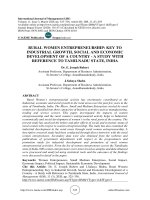Economic growth and economic development 583
Bạn đang xem bản rút gọn của tài liệu. Xem và tải ngay bản đầy đủ của tài liệu tại đây (100.67 KB, 1 trang )
Introduction to Modern Economic Growth
Exercise 12.13. Suppose that v (y) = y 1−α / (1 − α) with α ∈ (0, 1). Suppose also
that new varieties can be introduced at the fixed cost µ.
(1) Suppose that the allocation is determined by a social planner, which also
decides prices. Characterize the number of varieties that a social planner
would choose in order to maximize the utility of the representative household in this case.
(2) Suppose that prices are given by (12.12). Characterize the number of varieties that the social planner would choose in order to maximize utility of
the representative household in this case.
(3) Characterize the equilibrium number of varieties (at which all monopolistically competitive variety producers makes zero profits) and compare this
with the answers to the previous two parts. Explain the sources of differences between the equilibrium and the social planner’s solution in each
case.
Exercise 12.14. This exercise asks you to work through the Salop (1979) model
of product differentiation, which differs from the Dixit-Stiglitz model in that equilibrium markups are declining in the number of firms. Imagine that consumers are
located uniformly around a circle with perimeter equal to 1. The circle indexes
both the preferences of heterogeneous consumers and the types of goods. The point
where the consumer is located along the circle corresponds to the type of product
that he most prefers. When a consumer at point x around the circle consumes a
good of type z, his utility is
R − t |z − x| − p,
while if he chooses not to consume, his utility is 0. Here R can be thought of as
the reservation utility of the individual, while t parameterizes the “transport” costs
that the individual has to pay in order to consume a good that is away from his
ideal point along the circle. Suppose that each firm has a marginal cost of ψ per
unit of production
(1) Imagine a consumer at point x, with the two neighboring firms at points
z1 > x > z2 . As long as the prices of these firms are not much higher
than those further a far, the consumer will buy from one of these two firms.
569









